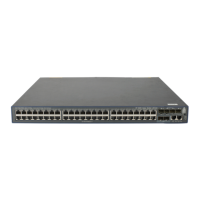236
Step Command Remarks
1. Enter system view.
system-view N/A
2. Enter BGP view or BGP-VPN
instance view.
• Enter BGP view:
bgp as-number
• Enter BGP-VPN instance view:
a. bgp as-number
b. ip vpn-instance
vpn-instance-name
N/A
3. Enter BGP IPv4 unicast
address family view or
BGP-VPN IPv4 unicast
address family view.
address-family ipv4 [ unicast ] N/A
4. Advertise the COMMUNITY
or extended community
attribute to a peer or peer
group.
• Advertise the COMMUNITY
attribute to a peer or peer
group:
peer { group-name |
ip-address }
advertise-community
• Advertise the extended
community attribute to a peer
or peer group:
peer { group-name |
ip-address }
advertise-ext-community
By default, the COMMUNITY or
extended community attribute is
not advertised.
5. (Optional.) Apply a routing
policy to routes advertised to
a peer or peer group.
peer { group-name | ip-address }
route-policy route-policy-name
export
By default, no routing policy is
applied.
To configure BGP community (IPv6):
Step Command Remarks
1. Enter system view.
system-view N/A
2. Enter BGP view.
bgp as-number N/A
3. Enter BGP IPv6 unicast
address family view.
address-family ipv6 [ unicast ] N/A
4. Advertise the COMMUNITY
or extended community
attribute to a peer or peer
group.
• Advertise the COMMUNITY
attribute to a peer or peer
group:
peer { group-name |
ipv6-address }
advertise-community
• Advertise the extended
community attribute to a peer
or peer group:
peer { group-name |
ipv6-address }
advertise-ext-community
By default, the COMMUNITY or
extended community attribute is
not advertised.

